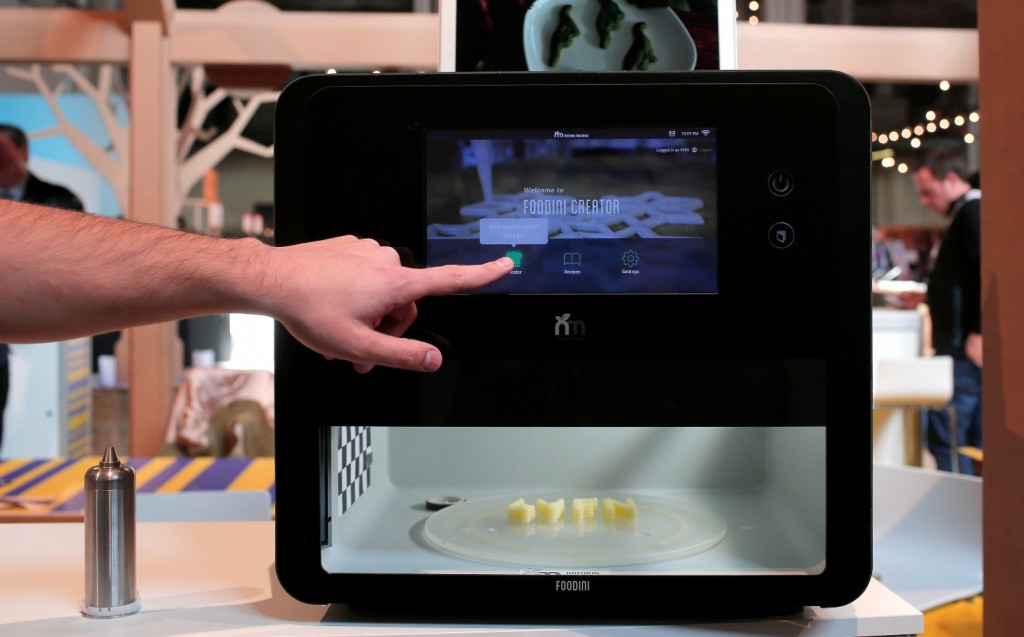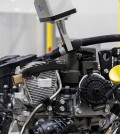- California Assembly OKs highest minimum wage in nation
- S. Korea unveils first graphic cigarette warnings
- US joins with South Korea, Japan in bid to deter North Korea
- LPGA golfer Chun In-gee finally back in action
- S. Korea won’t be top seed in final World Cup qualification round
- US men’s soccer misses 2nd straight Olympics
- US back on track in qualifying with 4-0 win over Guatemala
- High-intensity workout injuries spawn cottage industry
- CDC expands range of Zika mosquitoes into parts of Northeast
- Who knew? ‘The Walking Dead’ is helping families connect
Food printers and eye writing: tech show’s quirkiest gadgets
BARCELONA, Spain (AP) — While tens of thousands flock to the Mobile World Congress to check out the latest smartphones, the show also offers glimpses of some of the coolest off-beat — and downright strange — innovations.
Many of these newfangled prototypes found a niche at the trade show’s special corner for start-ups, which gathered here to find business deals for their inventions.
Here is a look at the quirkiest of the gadgets and apps on display this week in Barcelona.

A man touches the screen of a 3-D food printer during the Mobile World Congress wireless show in Barcelona, Spain, Tuesday, Feb. 23, 2016. Natural Machines co-founder Lynette Kucsma insisted her company hadn’t replicated Star Trek’s “food synthesizer” that made munchies appear at Captain Kirk’s mere command. But they sure have come pretty close with their 3-D food printer. (AP Photo/Manu Fernandez)
FOOD PRINTER
Natural Machines co-founder Lynette Kucsma insists her company hasn’t replicated Star Trek’s “food synthesizer” that made munchies appear at Captain Kirk’s mere command.
But they sure have come close with their 3-D food printer.
The Foodini lays down layer after layer of food from nozzles, ultimately creating treats like ravioli, crackers, or chicken nuggets. The company says you can even make more complex items like hamburgers, though it’s not clear what they would look like coming through nozzles.
“You become the food manufacturer,” Kucsma said, adding that the Foodini would allow cooks to use more natural ingredients to make healthier food instead of buying prepared foodstuffs with added preservatives.
The Foodini can also link up with other connected devices. “You can print recipes from a chef who is halfway around the world,” Kucsma said.
The Barcelona-based company is launching the Foodini with the target of professional chefs to meet the $1,500-2,000 price tag. They plan to later expand to regular customers.
“In 10 to 15 years we think 3-D food printers will be as common in kitchens as microwaves,” Kucsma said.
___
MAGIC DRAWINGS
Remember pop-up books?
Chromville takes the idea to another dimension with its augmented reality educational app.
Here is how it works: Kids download and print pages with designs that they color in as they wish.
Next, they hold a tablet over the page and, via the Chromville app, the drawing turns into a 3-D image they can interact with through the screen.
The one on the solar system, for example, lets kids explore the planets, zoom in and out, and learn facts. Other modules teach about the human body, the metamorphosis of a frog, simple geography, or how to build a machine.
“It is something like magic. We have to play and enjoy education,” said Hector Perez, CEO of the company from Zaragoza, Spain.
As of December, a one-time fee of 3.99 euros ($4.39) gives customers the app and access to drawings.
___
EYE WRITING
We can write with our touch. We can write with our voice. Irisbond is making it easier to write with our sight.
Their eye-tracking app, which can work with standard smartphone cameras, allows you to type on a computer.
Co-founder and CEO Eduardo Jauregui said the app is designed for disabled users.
“They can send emails or write books with their eyes. It changes their lives completely,” Jauregui said.
But it could also be helpful for professionals, like surgeons, who may have limited use of their hands during work.
Irisbond allows users to control a mouse pointer on a virtual keyboard of a smartphone or tablet. Stare for one second over a letter to “push” the button and type.
Jauregui said his company based in San Sebastian, Spain, is in talks with smartphone makers, including Samsung, to be acquired.
___
PAPER PROGRAMMING
Take paper art, a little round robot, throw in some low-level coding, and, voila! You have the Kamibot, an interactive toy that helps children have fun while learning computer programming.
Aimed at kids as young as eight, the Kamibot robot can be covered with paper-made “skins” to turn it into a variety of characters, including Dracula, Frankenstein, and several popular figures in Korea.
An app controls the robot’s movement, and teaches users how to program routes for the robot to follow.
Head of design Asaph Kim said “the idea was making programming fun through characters (children) have seen on TV.”
Still at the kick-starter phase, the Korean company 3.14 is hoping to ship its first Kamibots in June. Pre-orders go for $89.
___
PACK ROBOTS
One gadget that caused a big stir as it moseyed through the aisles of the trade show was Starship’s delivery robot.
Don’t let the company’s name fool you.
The tub-sized robot on rollers won’t blast you away, but it just might make home delivery more convenient as it creeps its way down the sidewalk.
Co-founder Janus Friis, one of the creators of Skype, had the idea to create a fleet of wheeled robots that would work with stores making deliveries from hubs that cover neighborhoods.
Keith Cornell, Starship’s senior advisor, said customers would gain from being able to decide exactly when they receive their packages, while stores will reduce costs.
To ensure the robot doesn’t cause mayhem on the street, its max speed is a slow 4 mph and it includes sensors that force it to stop when facing an obstacle. If stuck, it can be taken over remotely by an operator.
Customers will use an app to program the drop-offs and unlock the robot once it arrives to retrieve their goods. It can carry up to 20 pounds of stuff.
Still in testing phase, these modern-day pack mules are expected to be deployed in 2017.
















Postcards
October 21, 2017 at 1:15 AM
Welcome to printing.com, the home of low cost, hi-definition print with beautiful design from local printing.com studios.